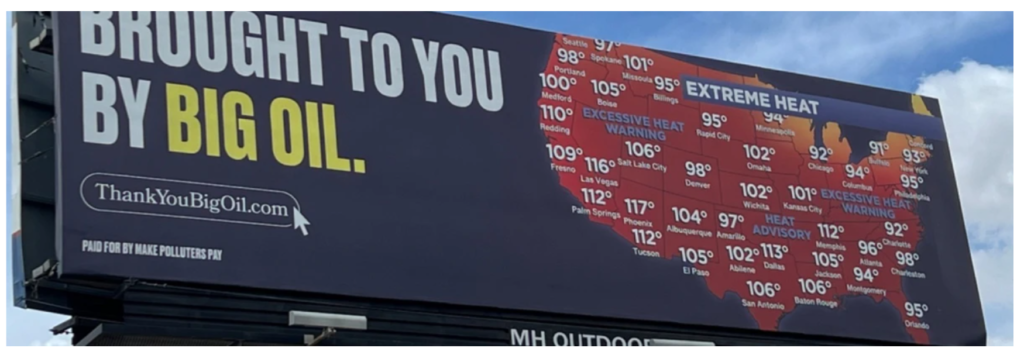Sign up for CleanTechnica’s Weekly Substack for Zach and Scott’s in-depth analyses and high level summaries, sign up for our daily newsletter, and/or follow us on Google News!

Climate litigation in the US has been ongoing for well over a decade. Various states, countries, and cities have filed claims against fossil fuel companies, alleging they should be held responsible for the economic harm they have caused. Primarily, the various plaintiffs say that the carbon dioxide released when fossil fuel products are used has led to a rise in global temperatures that has resulted in more destructive storms, wildfires, and rising sea levels. For their part, the companies claim that all they do is extract fossil fuels. What their customers do with them has nothing to do with them. This is very much like the situation Tom Lehrer described in his satirical song about the man whose rockets rained down on London during World War II: “‘Once the rockets are up, who cares where they come down? That’s not my department!’ says Werner Von Braun. ”
Scope 1, Scope 2, and Scope 3 Emissions
For those who have not been following this debate as it has unfolded, corporations are said to have three kinds of emissions, known as Scope 1, Scope 2, and Scope 3. Most of us could not accurately define them, so before going any further, let’s do that. National Grid has done so in a way that is fairly easy to understand, so for the purposes of this discussion, we will use their explanation:
Essentially, scope 1 are those direct emissions that are owned or controlled by a company, whereas scope 2 and 3 indirect emissions are a consequence of the activities of the company but occur from sources not owned or controlled by it.
- Scope 1 covers emissions from sources that an organisation owns or controls directly – for example from burning fuel in our fleet of vehicles (if they’re not electrically-powered).
- Scope 2 are emissions that a company causes indirectly and come from where the energy it purchases and uses is produced. For example, the emissions caused when generating the electricity that we use in our buildings would fall into this category.
- Scope 3 encompasses emissions that are not produced by the company itself and are not the result of activities from assets owned or controlled by them, but by those that it’s indirectly responsible for up and down its value chain. An example of this is when we buy, use and dispose of products from suppliers. Scope 3 emissions include all sources not within the scope 1 and 2 boundaries.
Most CleanTechnica readers have little difficulty making the connection between fossil fuel activities and the warming of the planet. We understand that putting billions and billions of tons of carbon dioxide and methane into the atmosphere to heat our homes, drive our cars, and power our industries has been the primary reason why global temperatures are rising. We also understand that the current economic system preferred by most nations assigns no costs to the waste products created by these giant corporations.
But how do we prove all that in a court of law? How can we say the emissions of GigantaCorp did this specific thing or those of Methane-R-Us did that? Courts do not rule based on supposition, suspicion, or say-so. They rule on facts, and those facts begin with data.
Fossil Fuel Attribution Research
Justin Mankin is a climate scientist and associate professor of geography at Dartmouth College. Christopher Callahan is a postdoctoral researcher in Earth system science at Stanford University. Together, they have written a study published on April 23, 2025, in the journal Nature. They claim it provides the scientific and statistical basis for proving those lawsuits in courts. Here is the abstract of their study:
Will it ever be possible to sue anyone for damaging the climate? Twenty years after this question was first posed, we argue that the scientific case for climate liability is closed. Here we detail the scientific and legal implications of an ‘end-to-end’ attribution that links fossil fuel producers to specific damages from warming. Using scope 1 and 3 emissions data from major fossil fuel companies, peer-reviewed attribution methods and advances in empirical climate economics, we illustrate the trillions in economic losses attributable to the extreme heat caused by emissions from individual companies. Emissions linked to Chevron, the highest-emitting investor-owned company in our data, for example, very likely caused between US $791 billion and $3.6 trillion in heat-related losses over the period 1991–2020, disproportionately harming the tropical regions least culpable for warming. More broadly, we outline a transparent, reproducible and flexible framework that formalizes how end-to-end attribution could inform litigation by assessing whose emissions are responsible and for which harms. Drawing quantitative linkages between individual emitters and particularized harms is now feasible, making science no longer an obstacle to the justiciability of climate liability claims.
The first thing readers will notice is that “between $791 billion and $3.6 trillion” is a pretty big spread. Will that be a problem for judges and juries? Not really. They deal with such considerations every day when deciding what the value of a human life should be. The plaintiff’s attorney always make the deceased out to be the next Steve Jobs or Elon Musk. The Defendant’s attorney makes the deceased out to be a ne’er-do-well who would never amount to anything. The court is left to choose some middle ground between those two extremes.
Mankin and Callahan started with the Carbon Majors database, a project of InfluenceMap which tallies the annual emissions from fossil fuel and cement companies. With computer modeling, they simulate two worlds, the one we live in and one without the greenhouse gas emissions of whatever company or country is under study. According to Bloomberg, for each region, they use thousands of simulations to estimate how the pollution affects the global temperature and how that influences heatwaves locally and the resulting economic drag. By comparing the two scenarios, they can put a value on the impact of the particular emissions. Each step is resolved with an open, peer-reviewed process.
$28 Trillion Damage From Fossil Fuel Use
By so doing, they conclude the world would have become as much as $28 trillion richer between 1991 and 2020 without the greenhouse gas pollution contributed by 111 of the companies listed in the database. The two biggest state-owned fossil-fuel companies — Aramco and Gazprom — are each responsible for about $2 trillion in lost global economic growth from extreme heat. The paper focuses on the effects major carbon emitters may have on economic losses from heatwaves — the hazard most easily attributable to greenhouse gas pollution. But that is only one example of how their research can be used. They say it can estimate the impacts of any source of emissions — an oil company, a country, a private plane — on any instance of harm.
Climate attribution research began after a 2003 essay in Nature asked, “Will it ever be possible to sue anyone for damaging the climate?” The first study measuring the effect of greenhouse gas emissions on a heatwave came out the next year. Several groups of researchers in the last decade developed approaches to quantify the climate impact on extreme events quickly, culminating in the work’s inclusion in the most recent UN climate science assessment.
Chevron cast both the study and attribution science as dubious. Theodore Boutrous of Gibson, Dunn and Crutcher LLP, counsel for Chevron, called the paper “baseless,” saying it “ignores the scientific impossibility of attributing particular climate and weather events to any specific country, company or energy user.” He associated the work with “a misleading advocacy campaign on behalf of wasteful and unconstitutional state lawsuits and energy penalty laws.”
Gazprom offered several criticisms of the study. The company expressed concern that the Carbon Majors emissions data counts gas that wasn’t actually burned for energy, but bought for use as a feedstock in fertilizer, plastics or industrial solvents, as combustion emissions, inflating the likely total. Gazprom said its gas sales to foreign markets have cut carbon dioxide emissions because the fuel has been replacing coal. “If Gazprom didn’t supply gas, energy importers would burn coal,” the company said.
Public Acceptance Of The Science Needed
Friederike Otto, co-founder of the research group World Weather Attribution, said the study is based on transparent and well-tested methods, but courts may not begin to rule in favor of climate litigants until society internalizes the findings. “The problem with the current lack of success of litigation against carbon majors is not the lack of scientific evidence,” she said.
Environmental attorney Matthew Pawa, who has been involved in high-profile lawsuits against energy and chemical companies, said the new paper gives an important analytical tool to plaintiffs. “It’s inevitable that at some point the fossil fuel companies will be held liable,” he said. “I’m where I was 20 years ago: You can’t do this much harm and not have committed a tort.” (A tort, for those of you who never went to law school, is a “civil wrong” between private parties.)
This latest research will be welcomed by attorneys general from the various states who have sued major fossil fuel companies and disparaged by those defending these corporations against such claims. Whether it will have any significant effect in pending and future climate litigation remains to be seen. Friederike Otto is correct. Juries are composed of ordinary people who are not climate scientists, and until those ordinary people accept the idea that these companies are responsible for trillions of dollars in damages, judgments against the emitters will be few.
Whether you have solar power or not, please complete our latest solar power survey.
Have a tip for CleanTechnica? Want to advertise? Want to suggest a guest for our CleanTech Talk podcast? Contact us here.
Sign up for our daily newsletter for 15 new cleantech stories a day. Or sign up for our weekly one on top stories of the week if daily is too frequent.
CleanTechnica uses affiliate links. See our policy here.
CleanTechnica’s Comment Policy




